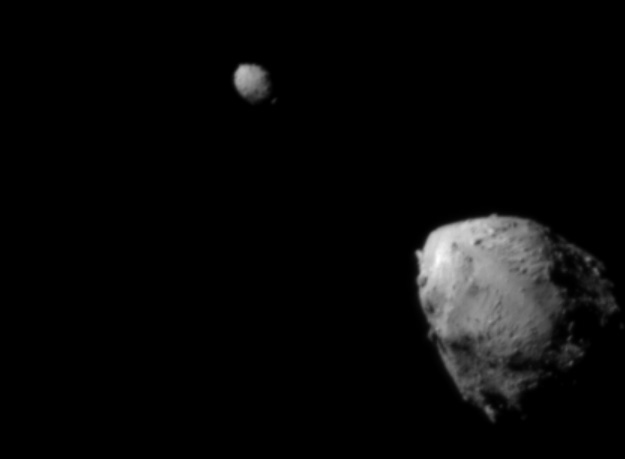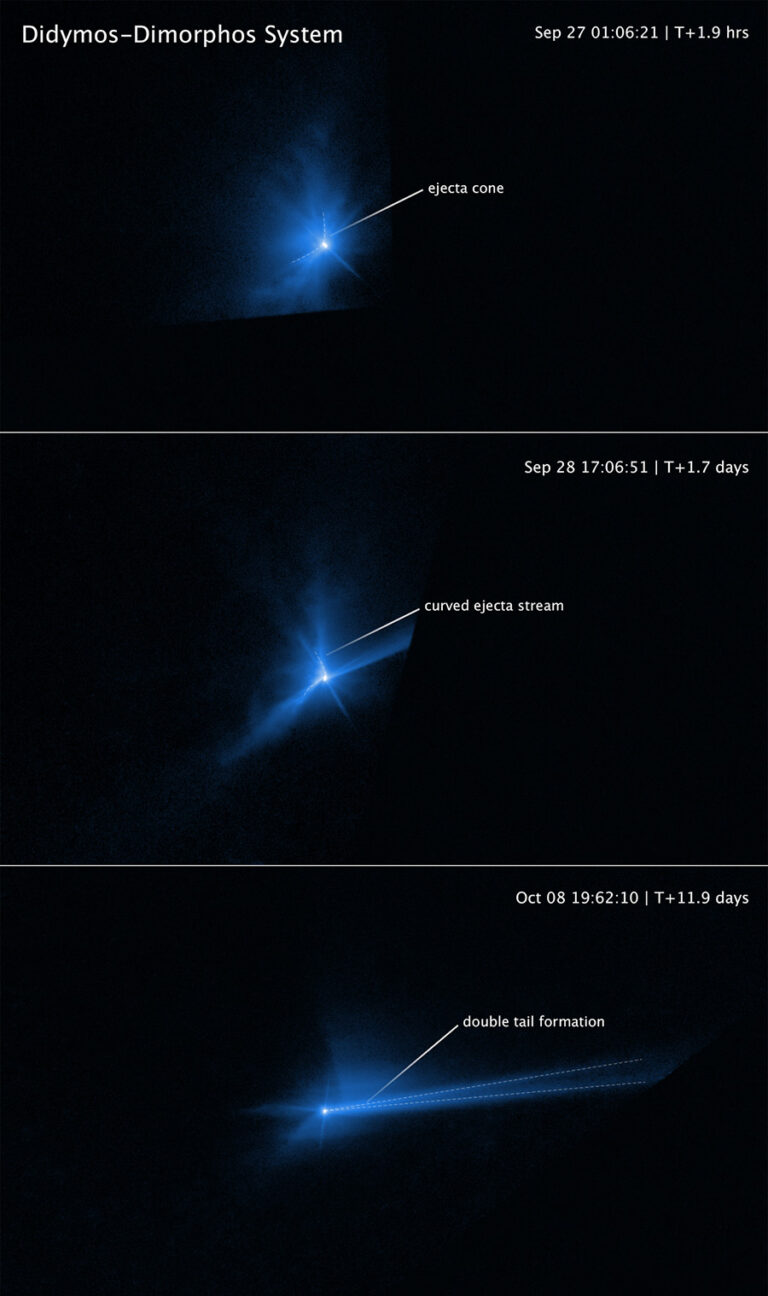[영어공부] DART 이후 인간의 지구 방위 임무의 향배
Sky and Telescope의 3월 1일자 웹 기사
THE AFTERMATH OF DART, HUMANKIND’S FIRST PLANETARY DEFENSE MISSION
BY: LAUREN SGRO MARCH 1, 2023
Five new studies give a full accounting of the aftermath of the impact of NASA’s DART mission on a nearby asteroid.
미국 항공우주국(NASA) DART의 지구근접 소행성 충돌 임무 수행 후 후속 연구논문 5편이 새로 발표됐다.
This image, taken from 570 miles (920 kilometers) away shows the asteroid Didymos (bottom right) and its moonlet, Dimorphos, about 2.5 minutes before the impact of NASA’s DART spacecraft. [NASA / Johns Hopkins APL]
소행성 디디모스(아래 오른쪽)와 달 디모포스의 모습을 보여주는 이 사진은 충돌하기 2.5분 전에 570마일에서 미국항공우주국 DART가 찍은 사진이다. [미국항공우주국/존스 홉킨스 응용물리 연구소 제공]
Last year, NASA intentionally crashed the Double Asteroid Redirection Test (DART) into a nearby asteroid to test our ability to defend the Earth from rocky threats. The results are now in – the DART mission was a smashing success.
작년 NASA는 이중소행성경로바꾸기 실험(DART) 탐사선을 위협이 될지도 모르는 암석 소행성으로부터 지구를 방어할 수 있을지 알아보려고 일부러 충돌 시켰다. 충돌 임무가 성곡적으로 행해진 이후 현재 그 결과는 성공적이다.
On September 26, 2022, DART hit its target asteroid Dimorphos, moon of the nearby asteroid 65803 Didymos, in a historic celestial experiment. Not only was DART the first planetary defense mission of its kind, but it marked the first time humanity was able to change the motion of a natural object in space. Initial estimations showed that Dimorphos' orbit shortened by 32 minutes due to the impact, proving a successful deflection.
Now, five papers published March 1st in Nature detail more about the collision’s aftermath, from the mass of the dust jettisoned from Dimorphos’ surface to the momentum transferred from the impact.
DIMORPHOS SHIFTED WHEN DART HIT
A team led by Terik Daly (Johns Hopkins Applied Physics Laboratory) used ground-based radar observations and images from DART’s onboard camera to model the shape of Dimorphos and recreate the moment of impact. Using these data, they make the first estimate of Dimorphos’ density: 2,100 to 2,700 kg per cubic meter. That’s roughly half the density of Earth, indicating the moonlet’s rubble-pile nature.
These three panels capture the effects of the DART impact on Dimorphos. Scence: NASA / ESA / STScI, Jian-Yang Li (PSI); Image processing: Joseph DePasquale (STScI)
위의 3장의 사진은 디모포스에 충돌한 DART의 효과를 보여준다. 첫번째 사진은 충돌 후 1.9시간 후, 1.7일 후, 11.9일 후 모습.
These characterizations of Dimorphos allowed Andrew Cheng (also at Johns Hopkins APL) and colleagues to simulate the change in Dimorphos’ velocity along its orbit. From these calculations, they assessed the momentum transferred to the unsuspecting asteroid during the collision.
Cheng’s team showed that the material knocked from Dimorphos’ surface during impact ended up transferring more momentum to Dimorphos than the DART spacecraft did by itself. Using LICIACube images, they find that the ejecta plume followed a direction nearly opposite and away from that of DARTs impact. That opposite reaction pumped more momentum into the system to bolster DART’s effect by 3.61 times, nudging Dimorphos into a new orbit.
“There were predictions of both high and low momentum transfer, so I can’t say I was very surprised, but I was expecting to see a lower momentum transfer [from the ejecta],” says Cheng, who is DART’s principal investigator.
CITIZEN SCIENTISTS CONTRIBUTE TO DART
Observers at large telescopes weren’t the only ones watching the DART impact. In a study led by Ariel Graykowski (SETI Institute), a light curve shows Dimorphos’ changes in brightness and color before, during, and after the impact — all made possible by the 31 citizen scientists who are listed as coauthors on the paper.
These observers, located across five continents, submitted data using their Unistellar eVscopes as part of Unistellar’s partnership with the SETI institute. Several of these avid skywatchers even caught the moment of impact.
Using the brightness measurements gathered by amateur astronomers, Graykowski’s team estimated the mass, speed, and energy of the ejecta. “Cheng and colleagues quantify exactly how much extra momentum the dusty ejecta must have transferred to the asteroid,” Graykowski says. “Our estimates from ground-based observations taken with small, 4.5-inch telescopes are in agreement.”
Graykowski and colleagues used the eVscope data to track the movement of the ejecta, and they calculated that the ejecta mass was only 0.3 to 0.5% of Dimorphos’ total mass. Despite the bright display of mass loss post-impact, this estimate confirms that the cosmic crash didn’t destroy Dimorphos.
Although the collision was not destructive, Jiang-Yiang Li (Planetary Science Institute) and his collaboration find that it did turn Dimorphos into an active asteroid with a tail and coma — like a comet but without the sublimating ice. Previously, astronomers suspected that natural impacts could make asteroids active, but no one had observed such an impact directly. Dimorphos’ newfound activity confirms this idea and gives scientists a real-life laboratory to study how it works.
This series of images captures the DART impact, as observed by Bruno Payet from the Réunion Island on September 26, 2022. [SETI Institute]
이 연속된 사진은 DART의 충돌의 직전후 모습을 보여준다. 리유니언 섬에서 2022년 9월 26일에 부르노 파옛에 의해 촬영되었다.
THE FUTURE OF PLANETARY DEFENSE
DART has made an impact on our understanding of asteroids and how we will guard Earth in the future, proving that we aren’t doomed to become the victims of a movie plot. Now that we have seen a kinematic impactor (that is, the DART mission) result in successful deflection, this method of planetary defense has moved from a theoretical possibility to a viable option to save our planet.
We will learn more about the post-impact Didymos system with the European Space Agency’s Hera Mission. Scheduled to launch October 2024, Hera will characterize and probe the surface of Dimorphos upon its arrival in 2026. “Most important is that Hera will measure the mass of Dimorphos,” notes Cheng. “Hera will also measure the size of the DART crater and measure the deformation, if any, of Dimorphos. These are critical data to better determine the amount of ejecta.”
Armed with a better understanding of DART’s effects on the Didymos system, humanity will be better prepared when an asteroid heads our way.



댓글 없음:
댓글 쓰기